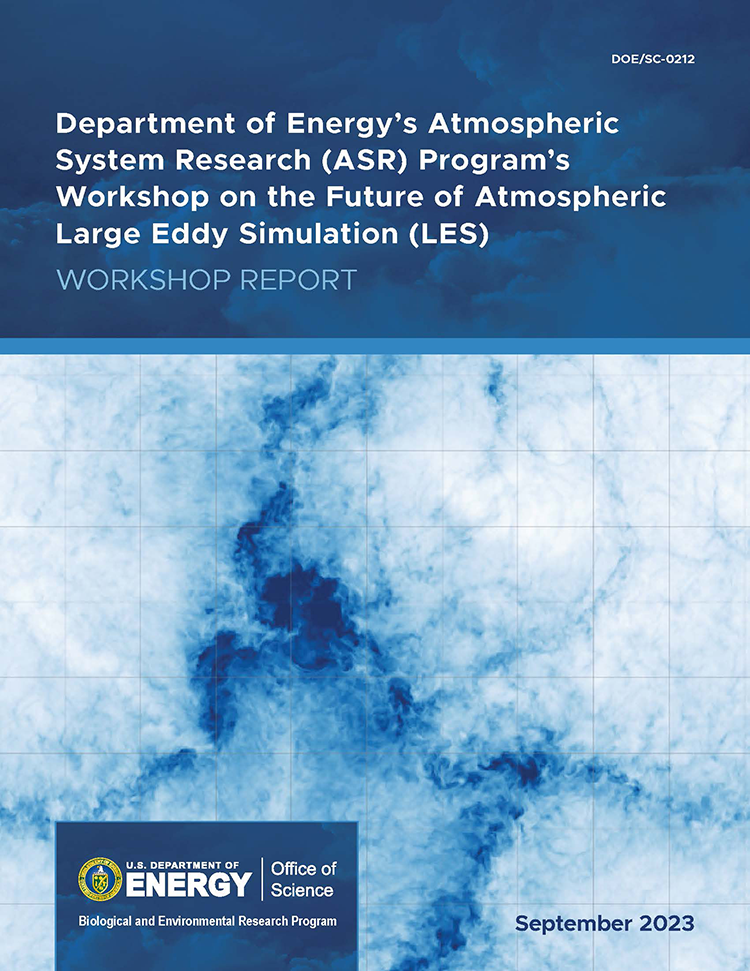ASR Workshop Report Explores Future of Atmospheric Large-Eddy Simulation
Published: 16 November 2023
Report discusses ARM LASSO activity, which combines observations and high-resolution modeling

The U.S. Department of Energy’s Atmospheric System Research (DOE ASR) program has published a new scientific report on the future of atmospheric large-eddy simulation (LES).
In April 2022, ASR held a two-day workshop on the future of atmospheric LES—a tool used to understand physical processes such as turbulence, aerosols, clouds, precipitation, radiation, the interactions among all these, and their interactions with the underlying surface.
“The workshop offered a rare, crosscutting setting in which LES users, observationalists, and model developers met to chart pathways forward to accelerate scientific progress,” explains the report’s lead author, Kyle Pressel, an earth scientist at Pacific Northwest National Laboratory in Washington state. “It was also timely, as advances in scientific computing and data science—if leveraged well—will yield new opportunities for transformative research.”
The workshop sought to answer five questions:
- What are the opportunities for LES-related research for atmospheric aerosol, cloud, and precipitation process studies over the next five to 10 years?
- What physical process representations in LES will limit research progress over the next 10 years?
- What aspects of current LES implementations will limit research progress over the next 10 years?
- What kind of observations would be useful in improving and further validating LES?
- What opportunities exist for improved synergy between observations and LES in studies of the atmosphere, and what are the challenges in doing so?
Current LES Support and Future Needs
The workshop report notes the use of long-term, high-resolution data from DOE’s Atmospheric Radiation Measurement (ARM) user facility to help improve and validate LES models.
“The workshop offered a rare, crosscutting setting in which LES users, observationalists, and model developers met to chart pathways forward to accelerate scientific progress.”
Workshop report lead author Kyle Pressel, Pacific Northwest National Laboratory
ARM also supports the LES ARM Symbiotic Simulation and Observation (LASSO) activity, which is discussed throughout the report.
LASSO combines observations and LES modeling to provide context and a self-consistent representation of the atmosphere around ARM sites. The LASSO team has produced simulations for shallow convection in Oklahoma and deep convection in Argentina. Next, the team plans to expand to simulations of marine clouds at ARM’s Eastern North Atlantic atmospheric observatory.
The report’s authors write that current DOE projects such as LASSO “are leading the way in conducting routine LES, building large, public databases that are accessible for data science, sensitivity studies, and training for machine learning.”
According to the report, LES will “drive fundamental progress in open scientific questions” over the next decade as LES is increasingly used to gain an understanding of complex interacting physical processes involving atmospheric turbulence.
This growth, the report states, will be driven both by scientific demand and the expansion of computational resources needed to conduct LES—and the form that growth takes will largely be determined by how these resources are leveraged for scientific gain.
While much has been done to help bridge the gap between models and observations, more can still be achieved.
The report describes specific observations that are needed to improve and further validate LES. They include continuous measurements of high-resolution vertical profiles and spatially distributed and co-located measurements over different land surfaces.
In addition, the authors suggest that modelers should participate in field campaign planning, starting at the proposal stage. Early involvement from modelers could help speed the production of case libraries that enable “rapid model evaluation against observations for a diverse range of conditions” and possibly allow for direct data assimilation into LES models, according to the report.
Keep up with the Atmospheric Observer
Updates on ARM news, events, and opportunities delivered to your inbox
ARM User Profile
ARM welcomes users from all institutions and nations. A free ARM user account is needed to access ARM data.


















